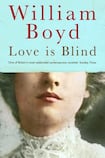
Raised by his stifling father, who preaches hellfire and brimstone from the apocrypha, Brodie Moncur lives in Edinburgh, working as a piano tuner at Channon’s. Called in by the manager one day, he is offered a role at the failing flagship branch of the piano-maker’s store in Paris, and takes his chance for escape. In Paris, he comes up with a plan for the business’s expansion: meeting the pianist John Kilbarron, dubbed “the Irish Liszt”, and offers him a fee for every concert he plays on a Channon piano. Quickly, the music world catches on, and Channon’s European sales take off. In Paris, Brodie also meets the intriguing Russian soprano Lika Blum, with whom he starts up a passionate affair. William Boyd’s latest novel charts that love affair, from Paris to St Petersburg, through narrative and letters, tracing one man’s journeying over the world during a decade at the turn of the 20th century.
Love is Blind has a beautiful sense of the power and charm of music. At the very beginning of the novel, while Brodie is tuning a piano, the instrument's open body is described in gorgeous detail: "The piano no longer seemed familiar. Now all the moving parts were visible beyond the black and white keys – the hammers, the rockers, the jacks, the whippens, the dampers – its innards were exposed like a clock with its back off . . . Mysteries – music, time, movement – were reduced to complex, elaborate mechanisms." Later, a Scottish folk song, remembered from childhood, plays a poignant role in the burgeoning pan-European love affair. The combination of music, romance and eroticism is hardly new, but it is pulled off with panache by Boyd, who uses the same tender detail for his precise descriptions of music as he affords to the novel's many trysts.
Greasy language
In some places, Love is Blind has a convincing sort of erotic charge; in others, the greasy language ("'I've been busy', he said, watching her breasts sway") leaves an uncomfortable sense of voyeurism and a feeling that the uneasy power relations in many of the scenes here have gone acknowledged but unexamined. Likewise, in the novel's final section, which takes place on the Andaman Islands, colonisation is given a dutiful nod but otherwise a fairly wide berth, and the queasy study of ethnography (Brodie falls in with an American ethnographer) is left largely unquestioned.
Unfortunately for a novel of such scope, the plotting is often boringly linear. One event leads so obviously to the next that there is very little space left for the reader to be surprised. One can imagine that the book was planned meticulously in advance, with each plot point being marked out on a timeline and then written. Each chapter becomes a servant to the forward-progression of the novel, so that by mid-way the whole thing seems slightly obvious, even laborious.
Framed for embezzlement
Some of the cliff-hangers, too, seem contrived. At one point, Brodie simply has “a sudden dark premonition” that life in a new city will be more dangerous, though this premonition is largely unexplained. Earlier, when Brodie is betrayed, framed for embezzlement, and fired, the whole plot point is pretty much resolved within a few paragraphs. At another point, when he spends time in a nursing home in France, the next chapter begins “It was as if Brodie’s months of convalescence in Nice had never happened.” That is, indeed, true. In fact, the point of the digression remains unclear except for padding out the overarching story of Brodie’s illness.
The novel is interspersed with letters to Lika, and letters home to Brodie’s brother that move the plot forward when the simple passing of an hour, or change of scene, won’t do. One can’t help but feel that most of the devices Boyd uses are about getting the plot down rather than exploring anything with more weight or significance. Overall, there is little to react to in Boyd’s novel – the writing is elegant, the characterisation plausible, the historical detail just on the right side of well-researched, the plot perfectly fine – but likewise there is little to write home about. An easy-going romance, a period drama, it is generally a satisfying read, though in the end it is too pedestrian, too plodding, to make any sort of long-lasting impact.










